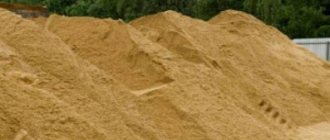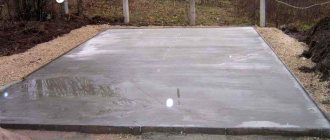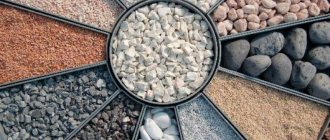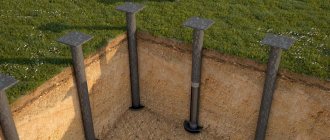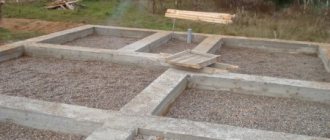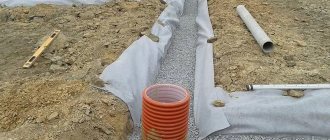Description and types
Screening is a fraction that is obtained by crushing rocks. A special sieve is used in this process.
Granite screening
For example, to obtain this additive from granite, it must be extracted by explosive means, crushed into pieces and sorted into fractions. It is worth noting that it is actively used both in housing, road, and other areas of production. This is due to the fact that granite provides the necessary durability and reliability. It is also used for decorative purposes.
As mentioned above, the screenings undergo mandatory sorting. Using a sieve, particles of a certain size are separated. Material with different fractions is used for mixtures that will later find use on various construction sites.
Concrete screening
In addition to granite screening, there is also concrete screening. It must be said that granotsev crumbs have a size from 0 to 10 mm. It has gray or reddish shades. By the way, reddish-colored material is used in the production of paving slabs. As for concrete screenings, this is the most accessible material that is obtained after recycling concrete. The particle size should be between one and ten mm.
The material is obtained through the process of mechanical crushing of concrete. This mixture is used for laying roads and landscaping areas. In particular, it is used to make asphalt and wall material. It should be noted that sometimes the admixture includes crushed brick. It is usually obtained by processing destroyed brick buildings.
It should be noted that the use of granite greatly reduces the cost of the solution compared to that made using crushed stone. At the same time, the structure acquires the necessary density and strength.
The main characteristic is that the mixture with concrete or granite screenings does not affect the quality characteristics of the structure. That is why these types are simply irreplaceable in construction.
Use of gravel and crushed stone.
Accordingly, taking into account the differences between gravel and crushed stone, they are used differently. Gravel (smooth pebbles) is used for decorative purposes, for sprinkling paths, compacting and leveling surfaces, and sometimes for concrete. Although for concrete, crushed stone obtained in the process of crushing large stones is preferable, since it is angular and not even and therefore holds better in concrete and is less likely to burst and crumble.
If you need crushed stone for concrete, then you can buy sanded crushed stone from us. This is crushed stone already mixed with sand; all you have to do is add cement and water, stir and the concrete is ready for use.
Answers to frequently asked questions regarding ASG, crushed stone and gravel, including their use in construction.
In low-rise or country house construction, you often have to buy ASG, crushed stone, sand, etc. And, of course, the question always arises: how or from whom to buy, so as not to waste money, how to buy better or more profitable, and in general, what is better specifically in my case. For example, what is better: ASG or crushed stone, what kind of ASG or crushed stone is it, etc.
We have to answer such questions quite often, so we have posted the answers to the most common of these questions here so that you, if you wish, can read and figure it out for yourself.
On this page we are talking only about ASG, crushed stone and gravel. We have a special page with answers to other frequently asked questions of a general nature, in which we answer all other questions regarding firewood, humus and other goods we deliver.
Which ASG is better for concrete.
It would probably be more correct to say which PGS, but that’s not the point. So, ASG is a natural mixture of sand, large and small stones, which is mined in a quarry. Formally, this is a ready-made mixture for mortar. But if the question is about which is better, then we sell sanded crushed stone - this is crushed stone already mixed with sand, you just need to add cement and water, mix and the concrete is ready for use.
Several reasons why this option is better:
- Sanded crushed stone contains only pure sand and crushed stone, that is, only what is needed for concrete and does not contain any other impurities that are found in natural ASG.
- Crushed stone (unlike stone in PGS) is crushed stone, so it is angular, not even, which means it holds better in concrete, breaks less, and crumbles less, unlike stone in PGS, which has rounded shapes.
Sand and crushed stone are mixed manually in optimal proportions.
Which is better, crushed stone or gravel?
And it depends on what for.. Each material is used for its own purposes and is the best in its field..)) Gravel is round pebbles, its best use is decoration, lawns, it is good to sprinkle paths with it, etc. Gravel can also be used to create concrete. Although crushed stone is more preferable for concrete, as we discussed above, since it is more angular. Unlike crushed stone and gravel, ASG is a ready-made mixture for concrete. You can immediately add cement and water to it. But, again, as we have already said, sanded crushed stone is even better suited for these purposes.
Component volumes
The main influence on the quality and strength of the structure is exerted by the correct proportions of all components of the mixture. It would be useful to note that granite screenings in their pure form are rarely used. Usually they partially replace sand in the composition or add part of gravel instead.
To correctly determine the proportion of concrete screenings, you need to subtract 1 part of crushed stone and sand from the standard proportion, and add two parts of it instead. For example, if the composition used 1 part cement, 4 parts crushed stone and 3 parts sand, then to prepare the batch you should take one part cement, 3 parts crushed stone and 2 parts screenings or sand.
Dropout quantity and concrete quality
In order to use one or another type of screening, it is necessary to determine the level of load that the coating will undergo. The temperature regime during operation of the coating will be important. As mentioned above, a solution using granite and cement material is more advantageous compared to a composition based on sand and crushed stone.
For example, to fill a yard, in addition to mortar, reinforcing mesh is used. In this case, the material is poured in a layer of 7 cm. Usually, if the mixture is based on granite material, then the following proportions are taken for the solution:
- 1 part cement M400;
- 8 parts dropouts;
- no more than 20% water.
This will result in a mass with a strength of M150. Granite will be an excellent mixture for pouring the foundation. Although when used to fill the yard, it is necessary to make a cushion of sand. Instead of sand, you can use the screening itself, which should be compacted and only then poured. Its thickness should be at least 5 cm.
It is worth saying in favor of granite material that its use is more profitable. To use granite in mortars, you need to replace part of the sand and part of the crushed stone with two parts.
Cement as the main component
And yet, no matter what screening is used, the main component of the solution remains cement, the quality of which determines what the building mass will be. The higher the grade, the stronger the finished material will be, namely, the adhesive ability will be high, which will give the necessary adhesion to the surface.
How long can the mixture be stored? It’s impossible for a long time, since the material will lose up to 10% of its strength in a month, and if stored for 2 years, it will become 50% less durable. You can check the quality and suitability for use by touch - take a small amount in your hand and lightly squeeze it. In this case, the cement should be crumbly. This suggests that the proportions of moisture and base still allow this material to be used effectively.
To improve the quality of cement, hydraulic additives are often added to it. The less the clinker is crushed, the higher the adhesive ability. Cement comes in various grades. Numerical designations indicate its strength. It should be noted that the choice is directly related to the load that the future foundation will have. Although most often cement M400 or M500 is used for these purposes. The second brand will be more expensive, but it also has better quality characteristics. The proportions are as follows: one cube of M-400 concrete contains 417 kg of cement, and one cube of M-100 concrete contains only 166 kg.
Dropout characteristics
The scope of application of screening depends on its characteristics, which are unique for each species. The main parameters are:
- Strength and ability to withstand a certain type of load;
- Maximum and minimum size of individual fractions;
- Bulk density;
- Resistance to low and high temperatures;
- The nature and characteristics of grain shapes;
- Mineral composition and amount of impurities;
- Level of radioactive radiation.
The main characteristics of different types of screening include flakiness. It shows the ratio of flat to oblong grains. The higher the flakiness of the screening, the more elongated grains it contains.
Granite screening has the greatest strength (1200M), which is capable of performing its duties at low temperatures. Granite screening can work on average from 250 to 310 seasons in a row, the level of flakiness reaches 14.4%, and the total volume of additional inclusions reaches 0.5%.
Read here! The best waterproofing mixtures - types of mixtures, methods of their use and features of penetrating compounds
Gravel screenings are characterized by lower strength indicators, which range from 800M to 1200M. The period of operation at low temperatures is 160 seasons in a row, flakiness is up to 18%, and the volume of third-party inclusions reaches 0.7%.
The weakest and most free-flowing is limestone screening; its strength can reach from 400M to 800M.
DIY solution
The solution can be easily prepared with your own hands. To do this, you will need a concrete mixer, and if it is not available, any construction container in which the mixing will be done. The required proportions of dry ingredients are poured into the mixer or container:
Next, they are mixed until a homogeneous mass is obtained. Lastly, water is introduced in small portions. In this case, the mixture must be constantly stirred. You need to make a homogeneous mass and moisture - then the solution is ready and can be used for work. It should be noted that the mass must be used within two hours after preparation, otherwise loss of its properties cannot be avoided.
If moisture evaporates during operation, it is necessary to add as much water to the mixture as necessary for the desired consistency. It should be noted that if any of the components is wet, then when manufacturing the building material it is necessary to reduce the amount of water.
Calculation and improvement of qualities
To improve the quality, it is necessary to sift the sand. It is worth paying attention to the fact that the composition of concrete of various grades greatly influences its shrinkage after pouring. Therefore, before determining how much composition will be needed and starting to calculate its quantity, it is necessary to decide on the brand of material. The higher the shrinkage factor, the more it will be needed to complete the job.
How much concrete is needed, for example, to pour a foundation? To calculate, you need to multiply the length by the width and multiply the resulting result by the height of the future foundation. Next, the resulting indicator is multiplied by the shrinkage coefficient. And after that, multiply by 1.05 again. This must be done in order to establish the volume that will be occupied by the fittings.
Proportions for preparing a solution from screenings and cement
The traditional composition of concrete, in addition to cement, includes a certain amount of sand and crushed stone.
The use of screenings as a filler - a by-product of grinding various rocks - reduces cement consumption and makes it possible to obtain a material with high performance indicators.
The variety of types and options of source rocks and degree of grinding makes screening a material capable of forming many types of concrete. The compositions obtained by combining different types of screenings and cement differ in qualities due to the properties of the initial material of the screenings.
Concrete made from cement and screenings
Screenings are the material obtained as a result of calibration, sifting, crushing of rock or building materials. This material is used in construction and road work. Concrete made from screenings and cement is considered a durable and economical building material. What types of screening are there? How to properly make a concrete composition from a cement-screening mixture? What proportions are used during the preparation of this composition? This will be discussed in this article.
Advantages and disadvantages of screening for paving slabs
When thinking about whether it is possible to lay paving slabs on screenings, you need to carefully study the properties of the material and scope of application. Screening for paving slabs is ideal - it not only allows you to lay out a layer evenly and compact it, but also effectively fills the seams between individual tiles. The material demonstrates good permeability, does not retain moisture, is not washed away by rain and does not sag under the influence of weather factors.
The main advantages of laying paving slabs for screening:
If you plan to lay screening tiles in conditions of wet soil or fresh embankment, it is advisable to add coarse crushed stone and lay geotextiles.
It is not advisable to study in detail the question of which screenings are best for paving slabs: almost all types of screenings demonstrate properties similar to those of sand. Therefore, you can choose any type of material, focusing on cost and assortment. To reduce the cost of the work carried out, it is recommended to choose screening of gravel or granite rocks.
Types of dropouts
Among the varieties of this material are:
Granite screening
Granite screenings are extracted by blasting granite rock and crushing. This kind of material is acceptable for road work, home repairs, and other construction and manufacturing industries. Such an abundance of applications is associated with the reliability, strength, and long service life of granite. Screenings from this breed can also be used for decorative purposes. This material comes in two colors: red and gray. Red is added to the composition when making paving slabs.
The material obtained after crushing granite is sifted through a special sieve and calibrated. Each fraction is used for certain types of concrete composition, the use of which is carried out in any construction. If you take crushed stone instead of granite, then such a composition will be much more expensive, and accordingly, it will not be profitable to use it. This will in no way affect the performance of the resulting solution.
Screenings from concrete
Concrete screening is more common. Its use is carried out much more often than other similar materials. And all thanks to the fact that concrete screenings are easy to obtain. It is enough to mechanically process and grind the waste concrete material. This material is used for laying roads, erecting walls, landscaping sites and territories, and is used in the preparation of asphalt mortar.
Concrete and brick screenings
Occasionally, brick chips extracted from used bricks are added to the concrete screening. Composite with screenings is suitable for laying the foundation for a building.
Positive qualities of concrete mixture from screenings
The strength of a concrete solution with added screenings is an order of magnitude higher than that of a mixture with sand. Therefore, builders often prefer the first option of concrete. This kind of composite has a high density, which has a good effect on its operation.
What is dropout
Many of you may have heard about crushed stone screening. It is often added to cinder block. Crushed stone screening is a bulk material with a fraction size of up to 5 mm. This is the rock that remains after crushed stone is sifted. When sifting such a mass, fine-grained quartz is separated, and gravel of different sizes or other natural substances of inorganic origin are used for screening. As a result, uneven material is obtained because it was not sifted through special sieves.
By the way, crushed stone screening is actively used in landscape design. Although it is perfect for covering playgrounds, parking lots or garden paths, it is used very carefully in concrete production.
The process of calibrating screenings into fractions
When crushing large stones or already used building materials, crumbs of different sizes come out, the sizes of which vary from centimeter-sized pebbles to dust-like particles. Separately selected screening particles of equal size are used for concrete mortar.
It is customary to sort crushed screenings in a long-known and effective way - the material is sifted through several special sieves installed one above the other, starting with the smallest, and further upward as the diameter of the holes in the sieve increases. The stone chips to be calibrated are poured onto the topmost, large sieve. Smaller particles from the contents of the first sieve are sifted onto the second, and then down through all levels of the so-called filter. At the end of the process, each sieve will have pebbles of the same size. In this way, the screening material is divided into fractions.
Component volumes
The quality and strength properties of the final product depend on the correct ratio of the added ingredients.
To accurately determine the required amount of concrete screenings, you should take one part of sand aggregate and crushed stone from the generally accepted proportion, and replace them with two parts of screening aggregate. To select the type of screening chips for mortar, you should find out the expected degree of load on the future structure or road surface. As mentioned above, a mixture based on granite chips is more advantageous compared to a mixture of sand and crushed stone. It is worth paying attention here to the temperature indicators during operation of the concrete structure or flooring.
If you plan to fill the area near a private house, you should use a reinforcing mesh, which is filled with a concrete solution no more than 7 cm thick. To prepare such a mixture, provided that granite chips are used, the following proportion is observed:
- 1 portion of cement grade M400;
- 8 servings of granite chips;
- maximum 20% water of the total volume.
The result will be a mixture with a strength of M150. Note that before pouring the site, you should lay a cushion on it, which can be made from granite screenings, trampling it thoroughly before pouring. The height of such a pillow should be at least 5 cm.
It is known that no mortar can do without cement, the quality and grade of which determine the performance characteristics of the concrete composite. The higher the marking of the raw materials used, the better the concrete’s ability to adhere to various surfaces.
As for the shelf life of cement, it cannot be left unused for a long time, as it loses its properties over time. After just a month, the strength of the material decreases by 10%. You can find out its suitability by scooping it up with your palm and squeezing it lightly in your hand. If the cement is crumbly, it means that it has not yet lost its quality; a solution made from such a binder will turn out good.
Let us recall that the level of strength of the composite depends on the marking of cement. For laying the foundation, grades M400 or M500 are used, since this structure is expected to bear a large load from the concrete or brick walls of the future building. The brand of cement also affects its cost. The most expensive one will have the highest marking and the best performance.
An important point is the quality and quantity of water poured. You need to add enough of it to get a mass of medium thickness. If you overdo it with liquid, the structure of the composite will be changed, which in the future can lead to large shrinkage of the structure, and consequently to cracking of the walls. As for quality, for high-strength concrete composites it is necessary to use drinking water rather than industrial water.
Which is better for the foundation: OPGS or PGS
It is impossible to imagine creating a solid foundation in construction work without the use of concrete mixture. It is this material that becomes the key to the long service life of any building and structure. That is why, when selecting building components for concrete production, you should be very demanding, choosing the optimal composition, brand, quality and particle size. In addition to cement, this also applies to the choice of ASG or OPGS for the foundation.
What is PGS or OPGS
ASG or sand and gravel mixture is a natural material. It is developed by quarrying, from the river bottom or in open deposits. Based on the level of inclusions, the percentage of sand and gravel, and the size of gravel particles, several types of this building material are distinguished. Basically, the gravel content in natural ASG does not exceed 20%, and this is where its main difference from OPGS is expressed.
OPGS is an enriched version of the natural mixture. Industrial addition of gravel can increase its content up to 75%. As practice shows, an important condition for a profitable purchase of PGS and OPGS is the reliability of the supplier.
Options for concrete made from ASG or OPGS for the foundation
Depending on the type of mixture, specialists select the most suitable percentage compositions of bulk and liquid components used in the production of concrete.
When using OPGS for pouring or laying a foundation, it is recommended to take 8 parts OPGS and 0.5 parts water for 1 part of cement by weight. It is recommended to take the classic version of ASG in concrete for the foundation in a weight ratio with cement equal to 6:1. From a practical point of view, the presence of a large amount of cement in concrete makes it “heavy” to work with, complicating both masonry and pouring.
If you choose between OPGS or PGS for the foundation, then the question of which is better to use should be based on the specific construction task. There is no doubt that OPGS can be added to cement practically from wheels, and the use of natural sand and gravel mixture often requires its additional enrichment manually. Concrete produced on a construction site is not only more profitable from an economic point of view, its quality can also be predicted by knowing what components are included in the initial mixture.
When purchasing OPGS or PGS for the foundation, you should take into account that the maximum size of the gravel grain should be no more than 8 cm. That is why for the construction of the foundation we supply high-quality ASG and OPGS that fully comply with the requirements of SNiP. The absence of intermediaries, our own supply in quantities of 1 ton - these are the conditions for a profitable purchase in our company. To order natural and enriched ASG, just call +7(8422) 69-10-82.
Recipe for concrete from screenings and cement
In order to prepare such a concrete mixture, you must strictly follow the instructions. The recipe for such concrete is:
- 1 part of cement marked M400;
- 8 parts of screening material;
- 20% liquid.
The dry ingredients should be mixed using a concrete mixer for several minutes. Then, without stopping the process, you need to gradually add water. The solution is ready when it reaches homogeneity and the desired thickness. Let us repeat that the resulting mass should be of medium thickness, and excess water will only worsen the quality of the finished product.
In order to improve the performance properties of the material, additives and impurities are mixed into the main components, giving the composite plasticity and increasing strength. Please note that the use of sealing admixtures is only suitable for mortars for laying roads.
Preparation of concrete mixture from screenings and cement
Carrying out construction work on their own, many developers think about making their own concrete mortar. In order for the mixture to be of high quality, certain nuances should be taken into account when creating it. In particular, you need to pay special attention to the choice of filler. Traditionally, sand is used as a filler, but screening is more popular in private construction. In this article we will look at how to make concrete from screenings and cement, the proportions in which it is best to mix the components, as well as the pros and cons of using this filler.

